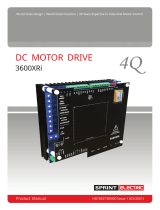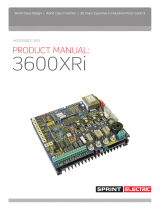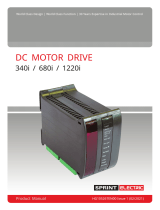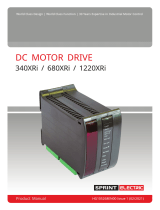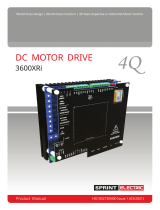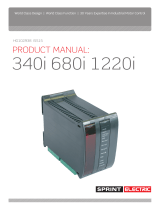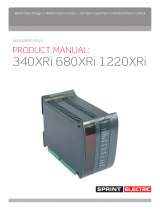Page is loading ...

HG105272EN00 Issue 1 (04/2021)
World Class Design | World Class Function | 30 Years Expertise in Industrial Motor Control
Product Manual
DC MOTOR DRIVE
1600i / 3200i

Please read this information before installing or using the product.
Install, use and maintain this product following the procedures provided.
The manual(s) cannot provide all details, variations and contingencies required for your
installation, operation and maintenance of this product or the apparatus with this product
installed. For further help or information, refer to your local Supplier sales offi ce.
Application area
The equipment described is intended for industrial (non-consumer) motor speed control.
Intended users
To safely enable the user to obtain maximum benefi t from the equipment:
• Ensure this information is available to all persons required to install, confi gure or service
the described equipment or any other associated operation.
• Always store the manual in a conveniently accessible area for quick reference.
• Make it available for the next user/owner of the product.
Safety
Ensure all users and operators understand the included WARNINGS, CAUTIONS and
NOTES, which alert the user to safety issues. COMPLY WITH WARNINGS AND CAUTIONS
AT ALL TIMES. Each of these carries a special meaning and should be read carefully:
WARNING!
A WARNING is given when non-compliance with the warning may result in
personal injury and/or equipment damage.
CAUTION!
A CAUTION is given when non-compliance with the caution may result in
permanent equipment damage.
NOTE A note provides specifi c information to make important instructions clear.
Symbols
Attention Electrostatic
Discharge (ESD)
Electric Shock
Hazard
See the instructions for use.
Specifi c warnings not found
on the label.
This equipment contains
ESD sensitive parts. Observe
static control precautions
when handling, installing
and servicing this product.
Disconnect the mains
supply before working on
the unit.
Do not touch presets,
switches and jumpers!
Always use the correct
insulated adjustment tools.
This product is of the restricted sales distribution class according to IEC 61800-3
and has a "professional equipment" designation as defi ned in EN 61000-3-2.

Installation
• Ensure mechanically secure fi xings are in use as recommended.
• Ensure cooling airfl ow around the product is as recommended.
• Ensure cables/wire terminations are as recommended and are torqued correctly.
• Ensure the product rating is correct - do not exceed the rating.
Application risk
Electromechanical safety is the responsibility of the user. The integration of this product
into other apparatus or systems is not the manufacturer's or distributor of the product's
responsibility. It is the user's responsibility to ensure the compliance of the installation with
any regulations in force.
Health and safety at work
Electrical devices can constitute a safety hazard. Thorough personnel training is an aid
to SAFETY and productivity. SAFETY awareness not only reduces the risk of accidents and
injuries in your plant but also has a direct impact on improving product quality and costs.
If you have any doubts about the SAFETY of your system or process, consult an expert
immediately. Do not proceed without doing so. If in doubt, refer to the Supplier.
CAUTION!
EQUIPMENT DAMAGE HAZARD
• We thoroughly test our products. However, before installation and start-up,
inspect all equipment for transit damage, loose parts, packing materials, etc.
• Installation must observe the required environmental conditions for safe and
reliable operation.
• In a domestic environment, this product may cause radio interference, requiring
adequate measures to be taken. Obtain the permission of the supply authority
before connecting to the low voltage supply.
WARNING!
PERSONAL INJURY AND/OR ELECTRICAL SHOCK HAZARD
• Always isolate all power supplies from the equipment before starting any work.
• Never perform high voltage resistance checks on the wiring without fi rst
disconnecting the product from the circuit under test.
• Use guarding and additional safety systems to prevent injury and electric shock.
• Metal parts may reach 90°C during operation.
Hazards
This equipment can endanger life through rotating machinery and high voltages.
WARNING!
Only qualifi ed personnel must install, operate and maintain this equipment.
A qualifi ed person is someone technically competent and familiar with all safety
information, established safety practices, installation, operation, maintenance
and the hazards involved with this equipment and any associated machinery.
General risks

Weight
Consideration should be given to the weight of our heavier products when handling.
Risk assessment
Under fault conditions or conditions not intended: the motor speed may be incorrect; the
motor speed may be excessive; the direction of rotation may be incorrect; the motor may be
energised.
In all situations, the user should provide suffi cient guarding and/or additional redundant
monitoring and safety systems to prevent risk of injury.
NOTE: During a power loss event, the product will commence a sequenced shut-down
procedure. Therefore, the system designer must provide suitable protection for this case.
Maintenance
Only qualifi ed personnel should maintain and effect repair using only the recommended
spares, alternatively return the equipment to the factory for repair. The use of unapproved
parts may create a hazard and risk of injury.
WARNING!
PERSONAL INJURY AND/OR EQUIPMENT DAMAGE HAZARD
When replacing a product, all user-defi ned parameters that defi ne the product's
operation must be installed correctly before returning to use. Failure to do so
may create a hazard and risk of injury.
The packaging is infl ammable and incorrect disposal may lead to the generation
of lethal toxic fumes.
Repairs
Repair reports can only be given if the user makes suffi cient and accurate defect reporting.
Remember that the product without the required precautions can represent an electrical
hazard and risk of injury, and that rotating machinery is a mechanical hazard.
Protective insulation
Isolated product
WARNING!
The drive and motor must be connected to an appropriate safety earth.
Failure to do so presents an electrical shock hazard. Exposed metal work in this
equipment is protected by basic insulation and bonding to a safety earth.
This product is classifi ed as a component and must be used in a suitable enclosure.
1. This is achieved through basic insulation and protective earth grounding, or double-
insulation to provide SELV Control Circuits.
2. This protection allows a safe connection to other low voltage equipment.
3. Earth bonding is the responsibility of the installer.

Contents
1 Introduction 11 Introduction 1
2 Installation 22 Installation 2
2.1 Motor installation .......................................................................................................... 2
2.2 Drive Installation ........................................................................................................... 2
2.3 Guide for systems used in the EU ................................................................................ 4
2.4 Multiple drives ............................................................................................................... 4
2.5 Requirements for EMC compliance ............................................................................. 5
2.6 Typical applications ....................................................................................................... 6
2.7 Blockdiagramandterminalspecications ................................................................. 8
3 Commissioning 113 Commissioning 11
3.1 Initial settings - without power ................................................................................... 11
3.2 Pre-operation motor check list ...................................................................................12
3.3 Operating the drive ......................................................................................................12
4 Options 144 Options 14
5 Trouble shooting 155 Trouble shooting 15
6Specications 166Specications 16


1
Introduction
1 1
IntroductionIntroduction
APPLICATION AREA: Industrial (non-consumer) "Motor speed control utilising DC Motors".
DRIVE
MODEL
AC SUPPLY
VOLTAGE
AMERICAN
OPTIONS
NOMINAL
OUTPUT
VOLTAGE
MAXIMUM
CURRENT
PRODUCT
DISSIPATION
at full current
ISOLATION
1600i/LV 60/30 48/24 16 A 50 W isolated
1600i 240/110 180/90 16 A 50 W isolated
3200i/LV 60/30 48/24 8/16/32/48 A 25/50/100/150 W isolated
3200i 415/240 240/110 320/180/90 * 8/16/32/48 A 25/50/100/150 W isolated
* USA
The 1600i and 3200i have identical functionality, however the 1600i is designed for operation
Line-to-Neutral (240 V nominal) and the 3200i for operation Line-to-Line (415 V nominal).
• All models are of open chassis construction for use in a suitable enclosure.
• The drives have isolated control electronics.
• Closed loop control of both armature current and feedback voltage for precise control of
motor torque and speed.
• Motor and drive are protected by a stall timer to automatically remove power after 30
seconds if the required speed cannot be achieved.
• Up to 150% of the preset maximum current for up to 30 seconds allowing for high, short-
term torques during acceleration etc.
• Independent control of either the current or speed loops by external inputs allow for
torque or speed control applications with overspeed or overcurrent protection.
• Demand signal can be derived from a potentiometer, 0-10 V signal or 4-20 mA loop.
• Speed feed back signal selection: ARMATURE VOLTAGE, or shaft-mounted TACHOMETER.
Input and
outputs
+aux input speed output +24 V unregulated output
-aux input current output +12 V regulated output
current input ramp output +10 V precision reference
4-20 mA input demand output -12 V regulated output
0 to 10 V input zero/stall relay -24 V unregulated output
Adjustable
parameters
Max speed Up ramp Max current
Min speed Down ramp IR comp
Stability
Switched
functions
Max current range Max feedback Tacho feedback
Relay function Power up hold AV feedback
Jumper
functions
Torque mode Dual supply voltage Phase angle limit
Zero reference interlock 4-20 mA input 50% stall threshold
Performance
features
Dual loop control Precisiontachorectier Compact design
Relay driver outputs International compatibility System inputs/ outputs

2
Installation
2 2
InstallationInstallation
WARNING!
ELECTRIC SHOCK HAZARD
Disconnect the mains supply
before working on the unit. DO
NOT TOUCH PRESETS, SWITCHES
AND JUMPERS! Always use the
correct insulated adjustment
tools.
2.1
Motor installation
• Foot-mounted motors must be level and
secure.
• Ensure accurate alignment of the motor
shaft and couplings.
• Do not hammer pulleys or couplings
onto the motor shaft.
• Protect the motor from ingress of
foreign matter during installation.
Earthing: Connect the motor to the system
enclosure earth.
2.2
Drive Installation
Requirements during installation and
operation:
• Optimisetheheatsinkairow.
• Avoid vibration.
• Protect the drive from pollutants.
• Ambient operating temperature must be
within -10ºC and +40ºC. To comply with
UL requirements, the temperature of the
surrounding air must not exceed 50ºC.
POWER CABLING: Use correctly rated
cable: minimum 600 Vac, 2 x armature
current
CONTROL SIGNALS: The 1600i and 3200i
have isolated control terminals and as such
may be connected to other systems. Avoid
running signal cables close to power cables.
SUPPLY: Please ensure that the supply
selection jumper on the drive matches the
incoming supply. Failure to do this may
result in permanent damage to the drive
unit and will invalidate any warranty.
FUSING: The drive MUST BE FUSED
EXTERNALLY with semiconductor fuses that
MUST be rated at 1.75 x armature current,
and have an A
2
s rating lower than the I
2
t
value listed on page 16. Any warranty
will be invalid if this fusing is incorrect.
1600i/3200i Fuse Holder Clearing I
2
t
8 A CH00620A CP102071 259 A
2
s
16 A CH00730A CP102053 259 A
2
s
32 A CH00850A CP102054 770 A
2
s
48 A CH00880A CP102054 2550 A
2
s
SUPPRESSION: The drives have excellent
noise immunity. However, installations
involving electrical welding or RF induction
heatingmayrequirefurtherltersonthe
line and armature terminals. Contactor coils
and sparking contacts may also require
suppression.A100Ωresistorinserieswith
a 0.1 µF capacitor is usually adequate in
these situations. Refer to page 5 for
EMC guidelines.
CAUTION!
EQUIPMENT DAMAGE HAZARD
Reversing systems: do not
transpose the armature
connections until the motor has
stopped, otherwise damage will
occur.
CAUTION!
EQUIPMENT DAMAGE HAZARD
For frequent stopping or jogging,
it is not good practice to rely on
switching the supply off and on
to stop and start with the run
contact permanently closed.
This may result in an
uncontrolled current pulse for
one half mains cycle under
certain conditions, e.g. main
contact bounce. This could lead
to undesired motor movement
or device damage.
In rapid start-stop systems, use
a spare normally-open contact
on the main supply contactor
in series with T7 and any other
RUN contacts.

3
Installation
2.2.1
Mechanical dimensions
The unit must have a substantial earth. Connect the earth to the heatsink earth screw
provided using a star washer to obtain optimum earth continuity.
Fixing bolts:
1600i M5 x 35 mm
3200i M5 x 50 mm
150 mm
150 mm
140 mm
150 mm
140 mm
85 mm
105 mm
200 mm
fin
fin
100 mm
75 mm
side view
side viewplan view
plan view
ER-1600i ER-3200i
airflow
airflow
150 mm
150 mm
140 mm
150 mm
140 mm
85 mm
105 mm
200 mm
fin
fin
100 mm
75 mm
side view
side viewplan view
plan view
ER-1600i ER-3200i
airflow
airflow
Figure 1 Mechanical dimensions
1600i
3200i

4
Installation
2.3
Guide for systems used in the EU
Special consideration must be given to installations in member states of the European Union
regarding noise suppression and immunity. According to IEC 1800-3 (EN61800-3) the drive
unitsareclassiedascomplexcomponentsonlyforprofessionalassemblers,withnoCE
marking for EMC.
The drive manufacturer is responsible for the provision of installation guidelines.
The resulting EMC behaviour is the responsibility of the manufacturer of the system
or installation. The units are subject to the LOW VOLTAGE DIRECTIVE 73/23/EEC and
are CE marked accordingly.
Following the procedures outlined below will normally be required for the drive system
to comply with the European regulations, some systems may require different measures.
Installers must have a level of technical competence to correctly install. Although the drive
unit itself is not subject to the EMC directive, considerable development work has been
undertaken to ensure that the noise emissions and immunity are optimised.
EN618003speciestwoalternativeoperatingenvironments.ThesearetheDomestic
(1stenvironment)andIndustrial(2ndenvironment).Therearenolimitsspeciedfor
conducted or radiated emissions in the industrial environment, hence it is usual for
theACsupplyltertobeomittedinIndustrialsystems.
Denitionofanindustrialenvironment:allestablishments,otherthanthosedirectly
connected to a low-voltage power supply network that supplies buildings used for
domestic purposes.
*
2.4
Multiple drives
Thearrangementshownbelowisformultipledriveswithonelter,showingthestarpoint
earthing method.
Theltershouldberatedfortheworstcasetotalarmaturecurrentload.Thedriveunits
aredesignedtofunctionnormallyonunlteredACsuppliessharedwithotherthyristorDC
drives. (Not AC drives).
DRIVE 1
AC SUPPLY
FILTER
UNIT
*
DRIVE 2
24V LOGIC CONTROL CLEAN EARTH
INSULATED FROM METAL WORK
ANALOGUE 0V (COM) CLEAN EARTH
INSULATED FROM METAL WORK
BACKPLATE
METAL WORK
DOORS
110V CONTROL
CUBICLE
METAL WORK
EARTH
STAR
POINT
INCOMING SAFETY EARTH
Figure 2 Star point connections for multiple drives

5
Installation
• Keep parallel runs of power and control cables at least
0.3 metres apart. Cross-overs must be at right angles.
• Keep sensitive components at least 0.3 metres from
the drive and power supply cables.
• TheACconnectionsfromtheltertothedrivemustbe
less than 0.3 metres or, if longer, correctly screened.
• DonotrunlteredandunlteredACsupplycables
together.
• Controlsignalsmustbelteredorsuppressed,e.g.
control relay coils and current carrying contacts. The
drivemodulehasbuilt-inltersonsignaloutputs.
• TheACsupplyltermusthaveagoodearthconnection
to the enclosure back plane. Take care with painted
metal to ensure good conductivity.
• TheACinputlterhasearthleakagecurrents.Earth
RCD devices may need to be set at 5% of rated current.
• ThemetalenclosurewillbeRFground.TheAClter,
drive earth and motor cable screen should connect
directly to the metal cabinet for best performance.
• Linear control signal cables must be screened, with
the screen earthed at the drive end only. Minimise the
length of screen stripped back and connect it to an
analogue earth point.
• (1) The motor cable must be screened or armoured
with 360 degree screen terminations to earth at each
end. The cable must have an internal earth cable and
the screen must extend into the enclosure and motor
terminal box to form a Faraday cage without gaps.
• (2) The internal earth cable must be earthed at each
end. The incoming earth must be effective at RF.
WARNING! The earth safety must always take
precedence.
2.5
Requirements for EMC compliance
WARNING!
ELECTRIC SHOCK HAZARD
AC supply lters
must not be used
on supplies that
are unbalanced or
oat with respect to
earth.
The drive and AC
lter must only
be used with a
permanent earth
connection. No
plugs/sockets are
allowed in the AC
supply.
The AC supply
lter contains high
voltage capacitors
and should not
be touched for a
period of at least 20
seconds after the
removal of the AC
supply.
DRIVE
CONTROL
TERMINALS
DRIVE
AC SUPPLY
INPUTS
DRIVE
EARTH
TERMINAL
ARMATURE
AND FIELD
OUTPUTS
CONTROL
SIGNAL
FILTERS
AC SUPPLY
FILTER
UNIT
*
dc drive module
User’s metal enclosure
1
2
Figure 3 Connections for EMC compliance

6
Installation
2.6
Typical applications
Figure 4 1600i: Basic connection
Figure 5 1600i: Basic connection with optional tacho
Figure 6 1600i: Torque control with overspeed limiting by separate setpoint
SPRINT ELECTRIC LTD. does not
accept any liability whatsoever for
theinstallation,tnessforpurposeor
application of its products. It is the users
responsibility to ensure that the unit is
correctly used and installed.
Health and Safety at Work
Devices constitute a safety hazard. It is
the responsibility of the user to ensure
compliance with any Acts or By-Laws
in force. ONLY skilled persons should
install this equipment.
+
+
+
+
+
1
+10
2
MIN
3
I/P
4
COM
5
COM
6
AUX
7
RUN
8
COM
9
TAC
10 11 12
13
A1+
14
A2-
15
F2-
16
F1+
17
L2/N
18
L
ERROR
AMP AND
FIRING CCTS
current
feedback
STALL
TIMER
SPEED ERROR AMP
feedback
max
speed
speed
demand
ramp reset
min
speed
COM
quench o/p
current
demand
stall
LOW
HIGH
SUPPLY
SELECT
stab
max
current
50/100%
S1 S2
S3 S4
5K
5K
S5
S6
6
torque
S8
tac/avf
COM
68
+24
67
IP
66
-IP
65
TI
64
-12
63
SS
62
+12
61
COM
58
DO
57
SO
56
RO
55
IO
54
ZS
53
ST
52
-24
51
Earth for protective
class 1 code
acw
cw
10K
RUN
CONTACT
MOTOR
ARMATURE
MOTOR
FIELD
AC I/P
DANGER
ELECTRIC SHOCK RISK
1
+10
2
MIN
3
I/P
4
COM
5
COM
6
AUX
7
RUN
8
COM
9
TAC
10 11 12
13
A1+
14
A2-
15
F2-
16
F1+
17
L2/N
18
L
acw
cw
10K
Close to run
AC I/P
Setpoint
(1 to 10K)
ARMATURE TIME
CONSTANT
T=L/R
armature
field
no field on
PM motors
tacho
(optional)
For half wave field output
connect field to F- and N.
Field volts = 0.45 x AC supply
DANGER
ELECTRIC SHOCK RISK
1
+10
2
MIN
3
I/P
4
COM
5
COM
6
AUX
7
RUN
8
COM
9
TAC
10 11 12
13
A1+
14
A2-
15
F2-
16
F1+
17
N
18
L
motor
For half wave field output
connect field to F- and N.
Field volts = 0.45 x AC supply
acw
cw
10K
RUN CONTACT
If the speed exceeds the level programmed
by the speed setpoint, then the current
demand comes out of limit and the speed
loop takes control.
TORQUE MODE SELECTED BY JUMPER
MOTOR
ARMATURE
MOTOR
FIELD
10K
acw
cw
AC I/P
DANGER
ELECTRIC SHOCK RISK
1
+10
2
MIN
3
I/P
4
COM
5
COM
6
AUX
7
RUN
8
COM
9
TAC
10 11 12
13
A1+
14
A2-
15
F2-
16
F1+
17
L2/N
18
L
Note: A2- and F2- are
internally connected.

7
Installation
Figure 7 3200i: Basic connection
Figure 8 3200i: Basic connection with optional tacho
Figure 9 3200i: Torque control with overspeed limiting by separate setpoint
SPRINT ELECTRIC LTD. does not
accept any liability whatsoever for
theinstallation,tnessforpurposeor
application of its products. It is the users
responsibility to ensure that the unit is
correctly used and installed.
Health and Safety at Work
Devices constitute a safety hazard. It is
the responsibility of the user to ensure
compliance with any Acts or By-Laws
in force. ONLY skilled persons should
install this equipment.
+
+
+
+
+
1
+10
2
MIN
3
I/P
4
COM
5
COM
6
AUX
7
RUN
8
COM
9
TAC
10 11 12
A1+
A2-
L2/N
L
F2-
F1+
13 15 16 17
1814
13
14
15 16 17
18
13
14
15 16 17
18
Note: A2- and F2- are NOT
internally connected.
For half wave field output
connect field to F- and N.
Field volts = 0.45 x AC supply
ERROR
AMP AND
FIRING CCTS
current
feedback
STALL
TIMER
SPEED ERROR AMP
feedback
max
speed
speed
demand
ramp reset
min
speed
COM
quench o/p
current
demand
stall
LOW
HIGH
SUPPLY
SELECT
stab
max
current
50/100%
S1 S2
S3 S4
5K
5K
S5
S6
6
torque
S8
tac/avf
COM
68
+24
67
IP
66
-IP
65
TI
64
-12
63
SS
62
+12
61
COM
58
DO
57
SO
56
RO
55
IO
54
ZS
53
ST
52
-24
51
FS2
FS1
Earth for protective
class 1 code
acw
cw
10K
RUN
CONTACT
MOTOR
ARMATURE
MOTOR
FIELD
AC I/P
1
+10
2
MIN
3
I/P
4
COM
5
COM
6
AUX
7
RUN
8
COM
9
TAC
10 11 12
A1+
A2-
L2/N
L
F2-
F1+
DANGER
ELECTRIC SHOCK RISK
acw
cw
10K
Close to run
Setpoint
(1 to 10K)
ARMATURE TIME
CONSTANT
T=L/R
armature
field
no field on
PM motors
tacho
(optional)
For half wave field output
connect field to F- and N.
Field volts = 0.45 x AC supply
1
+10
2
MIN
3
I/P
4
COM
5
COM
6
AUX
7
RUN
8
COM
9
TAC
10 11 12
motor
AC I/P
A1+
A2-
L2/N
L
F2-
F1+
DANGER
ELECTRIC SHOCK RISK
acw
cw
10K
RUN CONTACT
If the speed exceeds the level programmed
by the speed setpoint, then the current
demand comes out of limit and the speed
loop takes control.
TORQUE MODE SELECTED BY JUMPER
10K
acw
cw
1
+10
2
MIN
3
I/P
4
COM
5
COM
6
AUX
7
RUN
8
COM
9
TAC
10 11 12
MOTOR
ARMATURE
MOTOR
FIELD
AC I/P
A1+
A2-
L2/N
L
F2-
F1+
DANGER
ELECTRIC SHOCK RISK

8
Installation
2.7
Block diagram and terminal specications
1600i
3200i variation
1
2
3
4
5
6
7
8
9
10
11
12
13
14
15
16
17
18
+10
MIN
I/P
COM
COM
AUX
RUN
COM
TACH
A1
A2
F2
F1
N
L
68
67
66
65
64
63
62
61
COM
+24
+I/P
-I/P
TI
-12
SS
+12
58
57
56
55
54
53
52
51
COM
IO
ZS
ST
-24
DO
SO
RO
-
+
-
+
+
+
+
+
+
-
-
-
+
+
+10
RAMP OUTPUT RO 55
2.5V
4-20mA
50K
50K
5K
MIN
5K
+12
390R
2.5
DOWN UP
IR COMP
DEMAND
DO 57
STAB
LINK
50K
100K
470K
50%
100%
HOLD
100K
S7
MAX SPEED
SPEED
TORQUE
TD
RAMP
RAMP RESET
RANGE
S3 S4
.5
P+I
AMP
STALL
TIMER
DRIVE
RUN
LOGIC
RECTIFIER
MAX
CURRENT
CURRENT FEEDBACK
SPEED
OUTPUT
S8
5%
SO 56
ZS 53
ZERO
STALL
OUTPUT
ST 52
TI 64
CURRENT
OUTPUT
IO 54
ERROR
AMP
PHASE
SYNCH
FIRING
CIRCUITS
S1 S2
RANGE
STALL
S5
S6
ZERO
FIELD
BRIDGE
TAPPED
POWER
SUPPLY
TRF.
PSU
+24
+12
+10
-12
-24
150%
100%
50%
0%
7.5V
5V
2.5V
0V
ON
terminal-compatible signal pads
A+
A-
L2/N
L
TAPPED
POWER
SUPPLY
TRF.
FS2
FS1
F2-
F1+
PSU
+24
+12
+10
-12
-24
ON
Figure 10 Block diagram

9
Installation
1 +10 V precision reference. 10 mA maximum. Short-circuit proof
2 Minimum end of setpoint potentiometer or 4-20 mA current loop I/P
3 Speed demand input, 0-+10 V for 0-100% speed
4 Common - 4-20 mA return
5 Common - connect to earth for protective Class 1
6 Auxiliary input - on-board jumper selects direct speed or torque mode (0-10 V for
0-100% control)
7 Connect to COMMON to run 60 ms ON / 20 ms OFF
(WARNING:Runisanelectronicinhibitfunction.Theeldremainsenergisedand
all power terminals remain "live". RUN must not be relied upon during hazardous
operations)
8 Common - internally connected to T4, T5, T58, T68
9 Tacho input 25-400 V full scale, + or - polarity
10 Relay contact, normally-closed
11 Relay contact, normally-open
12 Relay pole
13 (A1+) armature output
14 (A2-) armature output
15 (F2-)eldoutput
16 (F1+)eldoutput
17 (N) AC supply input according to supply select jumper
18 (L) AC supply input according to supply select jumper
Relay contact rating: 1 A, 240 Vac
RATINGS ACCORDING TO CSA:
voltage rating of relay terminals
10/11/12 must not exceed 30 Vac
or 42.4 Vdc
Figure 11 1600i Terminal specications
68 Drive common
67 +24 V output, 25 mA maximum - do not short
66 Auxiliary speed input, 0 to +10 V for 0-100% ramped speed
65 Auxiliary inverting speed input, 0 to -10 V for 0-100% ramped speed
64 Input to current loop, 0-5 V for 100% current
63 -12 V output 10 mA maximum - do not short
62 Stop/start input:
close to -12 V to activate stall condition
close to +12 V to release stall condition
61 +12 V output, 10 mA maximum - do not short
58 Drive common
57 Speeddemandoutput0to-10Vrepresents0-100%demand(outputimpedance1kΩ)
56 Speed output - typically 7.5 V full scale adjustment of maximum speed preset will alter
the full scale reading from 4 V (anti-clockwise) to 9 V (clockwise)
55 Setpointrampoutput,0-10V,impedance1kΩ
54 Currentoutput,0-5Vfor0-100%ofchosenrange(S1,S2),1kΩimpedance
53 Zero speed relay driver output, maximum 100 mA,
switches to -24 V
52 Stall relay driver output, maximum 100 mA,
switches to -24 V
51 -24 V relay supply, 25 mA - do not short
RL
internal
transistor
T52 or T53
external relay
coil 2K8
from T51
Top terminals

10
Installation
1 +10 V precision reference. 10 mA maximum. Short-circuit proof
2 Minimum end of setpoint potentiometer or 4-20 mA current loop I/P
3 Speed demand input, 0-+10 V for 0-100% speed
4 Common - 4-20 mA return
5 Common - connect to earth for protective Class 1
6 Auxiliary input - on-board jumper selects direct speed or torque mode (0-10 V for
0-100% control)
7 Connect to COMMON to run 60 ms ON / 20 ms OFF
(WARNING:Runisanelectronicinhibitfunction.Theeldremainsenergisedand
all power terminals remain "live". RUN must not be relied upon during hazardous
operations)
8 Common - internally connected to T4, T5, T58, T68
9 Tacho input 25-400 V full scale, + or - polarity
10 Relay contact, normally-closed
11 Relay contact, normally-open
12 Relay pole
A1+ +armature output
A2- -armature output
L2/N AC supply input according to supply select jumper
L AC supply input according to supply select jumper
F2- -eldoutput
F1+ +eldoutput
Relay contact rating: 1 A, 240 Vac
RATINGS ACCORDING TO CSA:
voltage rating of relay terminals
10/11/12 must not exceed 30 Vac
or 42.4 Vdc
Figure 12 3200i Terminal specications
Top terminals
68 Drive common
67 +24 V output, 25 mA maximum - do not short
66 Auxiliary speed input, 0 to +10 V for 0-100% ramped speed
65 Auxiliary inverting speed input, 0 to -10 V for 0-100% ramped speed
64 Input to current loop, 0-5 V for 100% current
63 -12 V output 10 mA maximum - do not short
62 Stop/start input:
close to -12 V to activate stall condition
close to +12 V to release stall condition
61 +12 V output, 10 mA maximum - do not short
58 Drive common
57 Speeddemandoutput0to-10Vrepresents0-100%demand(outputimpedance1kΩ)
56 Speed output - typically 7.5 V full scale adjustment of maximum speed preset will alter
the full scale reading from 4 V (anti-clockwise) to 9 V (clockwise)
55 Setpointrampoutput,0-10V,impedance1kΩ
54 Currentoutput,0-5Vfor0-100%ofchosenrange(S1,S2),1kΩimpedance
53 Zero speed relay driver output, maximum 100 mA,
switches to -24 V
52 Stall relay driver output, maximum 100 mA,
switches to -24 V
51 -24 V relay supply, 25 mA - do not short
RL
internal
transistor
T52 or T53
external relay
coil 2K8
from T51

11
Commissioning
3 3
CommissioningCommissioning
3.1
Initial settings - without power
The suggested Comissioning strategy is to start in the safest possible mode of operation and
progressively exercise each element of the system until full functionality has been achieved.
For this reason, all drive units are shipped to run using:
• the highest supply option
• a nominal speed
• ARMATURE VOLTAGE feedback mode - we recommend that initial commissioning
is carried out in Armature Voltage feedback mode
• the lowest current range
3. Use switches S1 and S2 to select a suitable current range.
IMPORTANT*: The switch settings vary between the 1600i
Supply selection
Drive model HIGH position LOW position
1600i 240 V 110 V
3200i 415 V 240 V
LV60 60 V 30 V
1600i : current ranges*
S1 S2 Min. Max.
OFF OFF 0 A 4 A
ON OFF 0 A 8 A
OFF ON 0 A 12 A
ON ON 0 A 16 A
3200i : current ranges*
S1 S2 Min. Max. /8 /16 /32 /48
OFF OFF 0 A 2 A 4 A 8 A 12 A
ON OFF 0 A 4 A 8 A 16 A 24 A
OFF ON 0 A 6 A 12 A 24 A 36 A
ON ON 0 A 8 A 16 A 32 A 48 A
4. Use switches S3 and S4 to select a range suitable for the armature voltage at full speed.
For example, if the armature voltage is 180 V, then set S3:OFF and S4:ON for 100 to 200 V
voltage feedback.
1. To avoid damage, ensure the drive's supply
selection jumper matches the incoming ac
supply: 240 Vac or 110 Vac, (60 Vac or 30 Vac
for LV60 models).
2. Ensure switch S8 is set to ON, selecting AVF.
and 3200i. Refer to the table below.
For example, if your motor current rating is 6 A,
the switch settings for 1600i are SW1:ON and SW2:OFF,
but for 3200i/8 they are SW1:OFF and SW2:ON.
Refer also to "Figure 13 User adjustments" on page
13 for the following switch selections:
1600i
3200i

12
Commissioning
5. For an intial start, adjust the following presets:
3.3
Operating the drive
1. Note the armature voltage rating given on the motor rating plate.
2. Apply mains power to the unit. The ON lamp will light.
3. Close the RUN contact.
4. Gradually increase the external setpoint to start the motor rotating. If the direction is
wrong, TURN OFF THE POWER, WAIT FOR THE MOTOR TO STOP TURNING and swap over
the cables connected to the A1+ and A2- terminals.
5. MAX SPEED: Increase the external setpoint further to ramp up to full speed. Fine adjust
using the MAX SPEED preset to achieve the armature voltage stated on the motor rating
plate.
6. Reduce the external setpoint to ramp the drive to zero. The motor will stop rotating.
7. MIN SPEED: Adjust MIN SPEED to provide a speed preset.
8. RAMP UP/RAMP DOWN: Run the motor up and down while adjusting the RAMP UP and
RAMP DOWN potentiometers.
9. STABILITY: Adjust the STAB potentiometer to improve response. Clockwise rotation
gives a faster response. (Excessive rotation in either direction may lead to instability,
depending on load.)
10. IR COMP: Speed droop on heavy loads may occur where armature voltage feedback is
used. Compensate for this by clockwise adjustment of the IR comp preset. Excessive
rotation may lead to instability.
The drive is now commissioned for use in Armature Voltage feedback.
MIN SPEED Fully anti-clockwise
UP RAMP Fully anti-clockwise
DOWN
RAMP
Fully anti-clockwise
STABILITY Mid-way
IR COMP Fully anti-clockwise
MAX
CURRENT
Set MAX CURRENT from your motor rating plate. Rotating clockwise gives
0-100% of the drive current rating as set by switches S1/S2, e.g. if S1/S2 are
set to limit the current to 8 A, 50% rotation will give a 4 A current limit.
6. Ifatachogeneratoristted,disconnectthetachowirefromterminalT9andinsulate.
3.2
Pre-operation motor check list
With no power applied, complete the following check list:
• Check for the correct insulation between all motor windings and earth (disconnect all
drive cables before testing).
• Check inside the motor connection box for foreign objects, damaged terminals etc.
• Check that motor brushes are in good condition, correctly seated and free to move in
brush boxes.
• Check for the correct action of brush springs.
• Check that motor vents are free of any obstruction or protective covers.

13
Commissioning
Figure 13 User adjustments
WARNING!
When power is applied to the drive,
ALWAYS use an insulated tool when adjusting the presets.
Refer to the Supply Selection
table on page 11.
AC power is applied when lit.
Rotate clockwise to increase
current. S1 and S2 select the
range.
Rotate clockwise to increase
response. Excessive rotation
may cause instability. If rated
motor motor voltage is much
lower than AC supply then
anticlockwise is prefered.
Rotate clockwise to increase
level of armature voltage
droop compensation.
Excessive rotation may cause
instability. Always set fully
anti-clockwise in Tacho mode.
Rotote clockwise to increase
drive deceleration from 1 to
30 seconds - note that
natural coast down is a limit.
Rotate clockwise to increase
drive acceleration from 1 to
30 seconds.
Rotate clockwise to increase
minimum speed.
Use to adjust 4-20 mA loop
burden resistor between 0
and 390 Ω if 4-20 mA mode
is selected.
Rotate clockwise to
increase speed. Change the
range with S3 and S4.
Drive quenches when lit if stall timer trips - the
time depends upon the current demand:
STANDARD WITH 50% THRESHOLD
150% 30 secs 150% 5 secs
125% 60 secs 100% 30 secs
115% 120 secs 75% 60 secs
100% no trip 50% no trip
Link both and terminal 2 becomes loop I/P compliance 5 V, and terminal 4 is return.
Link just the lower pair for 0-20 mA.
Link for 50% STALL THRESHOLD.
MAXIMUM
SPEED
MINIMUM
SPEED
UP
RAMP
DOWN
RAMP
STAB
IR
COMP
MAXIMUM
CURRENT
TORQUE
SPEED
LINK FOR
4-20 MA
50% STALL
THRESHOLD
1 2 3 4 5 6 7 8
CURRENT
RANGE
SPEED
RANGE
RELAY
FUNCTION
HOLD
TACH/AVF
DRIVE STALL S5 ON
ZERO SPEED S6 ON
25%
50% 75%
100%
25 - 50
50-100
100-200
200-400
OFF ON
ON
STALL
1
+10
2
MIN
3
I/P
4
COM
5
COM
6
AUX
7
RUN
8
COM
9
TACH
10 11 12
A1+
A2-
F2-
F1+
N
L
F2-
F1+
A1+
A2-
L2/N
L
S1
S2
MAXIMUM
CURRENT
RANGE
Select between four maximum current ranges.
100% represents the maximum unit rating.
Use the MAX CURRENT PRESET to adjust from 0% to
the selected maximum percentage.
S3
S4
MAXIMUM
FEEDBACK
RANGE
Select between four maximum feedback voltage ranges.
Use the MAX SPEED PRESET to adjust within the
range. The drive will control from 0 V to the selected
maximum 0-10 V input.
S5
S6
RELAY
FUNCTION
Select the function of the internal relay:
S5 - when ON, the relay remains energised
until a stall condition occurs.
S6 - when ON, the relay is energised for
speeds 5% of full scale.
S5 & S6 - when both ON, the relay
de-energises when a stall condion occurs
AND the motor speed has fallen below 5%
of full scale.
S7 HOLD
When ON, the drive will power up in a stall
condition. It may be be reset by momentarily
shorting pad T61 to pad T62.
S8
TACH/AVF
Select the speed feedback source:
When ON, ARMATURE VOLTAGE is selected (default).
When OFF, TACHO is selected.
With a jumper in TORQUE position, terminal 6 is a torque input.
With a jumper in SPEED position, terminal 6 is a direct speed input.
1600i
3200i
S5
S6
3200i is 50 mm wider than 1600i.
A pair of 2 A fuses protect the field and
transformer. The supply select jumper is
located at the top right edge (HIGH/LOW).
DANGER!
ELECTRIC SHOCK HAZARD
415/240
AC supply voltage
legend, selector
marked HIGH/LOW
SUPPLY
SELECT
1600i
*
*
240
SUPPLY
SELECT
110
LV
60
LV
30
This jumper selects the appropriate supply tap
on the control transformer.
Refer to the specification for supply ranges.
ANTI-CLOCKWISE MID-WAY
CLOCKWISE
SUPPLY
SELECT
3200i
*
SUPPLY
SELECT
1600i 3200i
The 3200i is 50 mm wider than the 1600i.

14
Options
4 4
OptionsOptions
Consider the following changes to tune/improve the performance of the drive/system.
• SPEED FEEDBACK SELECTION If the system is to use Tacho feedback you can now adjust
for the tachogenerator's output voltage, and hence the speed of the motor.
NOTE: IR COMP must NOT be used with Tacho feedback - set the potentiometer
fully anti-clockwise.
a. With the power off, connect the tachogenerator's output voltage to Terminal 9.
Set the Tach/Avf switch S8 to OFF (left).
Calculate the output voltage from the tachogenerator:
For example, if quoted as "100 V per 1000 revs/min" then
feedback voltage = (motor speed/1000) x 100 V
Alternatively, it can be estimated as follows:
1. Whilst still in Avf mode and running at 100% speed, measure the tacho
volts on the wire intended for connection to Terminal 9 - WARNING:
possible high voltage. Note this voltage, stop the motor and turn off
the supply.
2. Set the Tach/Avf switch S8 to OFF (left) to disconnect Avf and then
reconnect the tacho wire to Terminal 9.
b. Reset switches S3 and S4 to a suitable range for the measured/calculated Tacho
voltage.
c. Run the drive using a low to middle speed setpoint.
d. Adjust the Max spd preset to achieve the required shaft speed at maximum speed
setpoint.
Run the drive in Armature Voltage feedback mode and check the polarity of the
tacho using a voltmeter. The tacho feedback polarity must be negative with respect to
COMMON, Terminal 8 for a Positive Speed Demand on Terminal 3.
WARNING!
PERSONAL INJURY HAZARD
Terminals A1+, A2-, F1+, F2-, L2/N & L are at high potential.
Do not touch the terminals or any connected conductor.
• TORQUE CONTROL MODE: Switch S3 allows a Torque signal to be entered when ON via
signal pad 64 (TI) which is on the top edge of the board.
/
